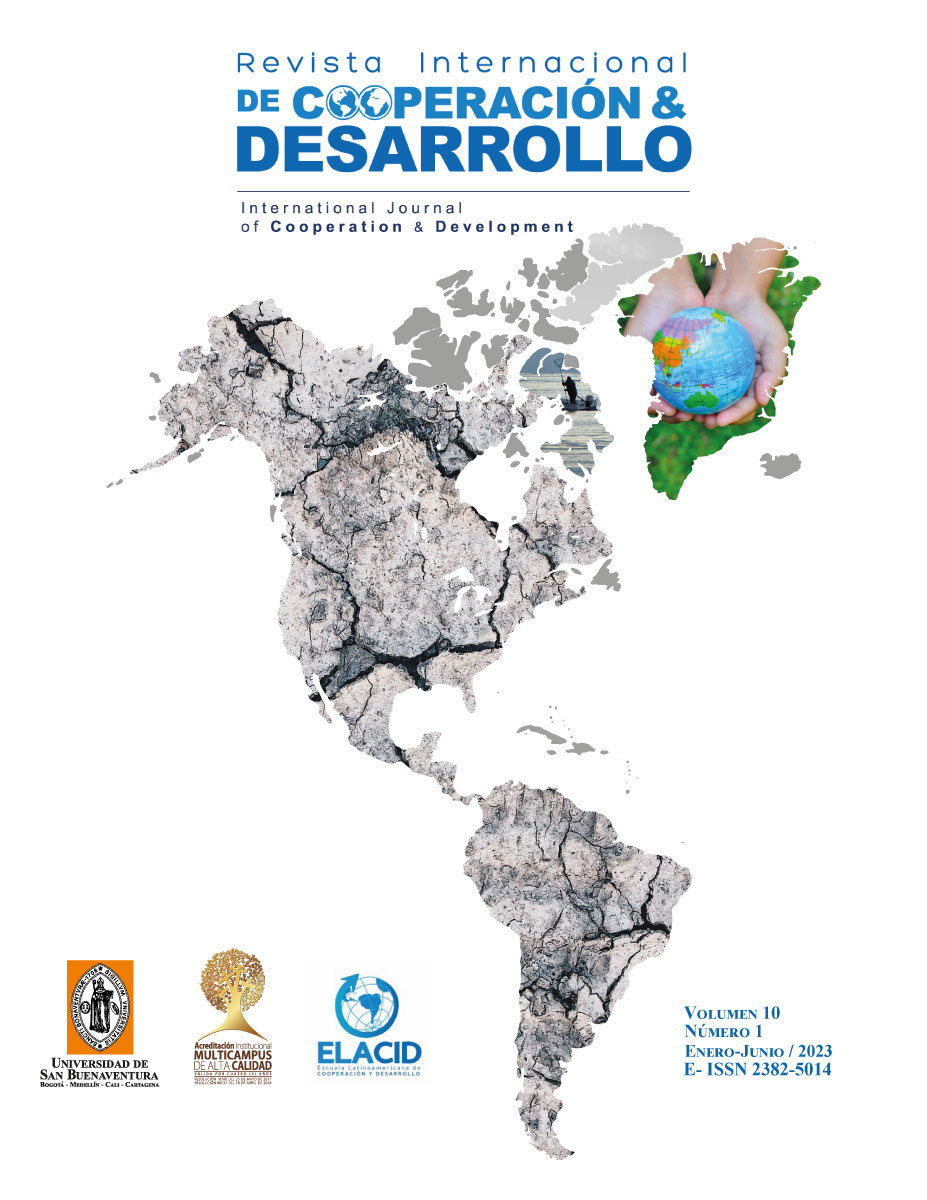Autorización para reproducción, publicación, comunicación y distribución de una obra literaria, artística o científica
Yo, ____________________________________________, autor de la obra y/o artículo, mayor de edad, de la ciudad de _________________, identificado con cédula de ciudadanía/ pasaporte n.°______________________, expedida en _______________________, en uso de sus facultades físicas y mentales, parte que en adelante se denominará el AUTOR, suscribe la siguiente autorización con el fin de que se realice la reproducción, publicación, comunicación y distribución de una obra, en los siguientes términos:
1. Que, independientemente de las reglamentaciones legales existentes en razón a la vinculación de las partes de este contrato, y cualquier clase de presunción legal existente, las partes acuerdan que el AUTOR autoriza a (nombre del editor), para que se reproduzca, publique, comunique y distribuya el material denominado en la Revista Internacional de Cooperación y Desarrollo de la Universidad de San Buenaventura.
2. Que dicha autorización recae en especial sobre los derechos de reproducción de la obra, por cualquier medio conocido o por conocerse, publicación de la obra, comunicación pública de la obra, distribución de la obra, ya sea directamente o a través de terceros con fines netamente educativos.
3. El AUTOR se compromete a informar y declarar la existencia de la presente autorización y a preservar el derecho de la Revista Internacional de Cooperación y Desarrollo a la primera publicación de LA OBRA.
4. El AUTOR declara que el artículo es original y que es de su creación exclusiva, no existiendo impedimento de ninguna naturaleza para la autorización que está haciendo, respondiendo además por cualquier acción de reivindicación, plagio u otra clase de reclamación que al respecto pudiera sobrevenir.
5. Que dicha autorización se hace a título gratuito.
6. Los derechos morales de autor sobre el artículo corresponden exclusivamente al AUTOR y en tal virtud, la Universidad de San Buenaventura se obliga a reconocerlos expresamente y a respetarlos de manera rigurosa.
El AUTOR y/o AUTORES
FIRMA
Resumen
El articulo ofrece una amplia panorámica del incremento de la desigualdad y construye una taxonomía internacional y multidimensional de la desigualdad económica. Se utiliza un análisis jerárquico de conglomerados que nos permite identificar cinco grupos de países con características distintivas de desigualdad económica, que muestran que, a pesar de las especificidades nacionales y regionales, tanto los países desarrollados como los países en desarrollo se enfrentan a importantes dificultades para reducir las disparidades sociales y económicas. La clasificación resultante puede ser útil para trazar un mapa de las distintas realidades nacionales de la desigualdad económica entre países. Los resultados sugieren que debería evitarse una estrategia internacional de "talla única" para abordar los diferentes patrones de desigualdad que hemos identificado en todo el mundo. Aun así, es crucial reconocer la importancia de las particularidades de cada grupo y de cada región geográfica en relación con un fenómeno complejo y multidimensional que se ha convertido en un reto global para el siglo XXI.
Palabras clave:
Referencias
Arrighi, G. 2007. Adam Smith in Beijing: lineages of the twenty-first century, Verso. London.
Atkinson, A.B. On the measurement of inequality, Journal of Economic Theory 1970;2: 244-263
Atkinson, A.B. Measuring Top Incomes: Methodological Issues. In: A. B. Atkinson and T. Piketty (eds.): Top Incomes over the Twentieth Century: A Contrast Between Continental European and English-Speaking Countries. Oxford University Press; 2007. p. 18-42.
Atkinson, A.B. Inequality. What can be done? Cambridge: Harvard University Press; 2015.
Atkinson, A. B. and Bourguignon F. (eds) Handbook of Income Distribution. Volume 2. Pages 1-2251. Amsterdam: North-Holland; 2015.
Atkinson, A.B., Piketty, T. and Saez, E. Top Incomes in the Long Run of History, Journal of Economic Literature 2011; 49:3-71.
Bourguignon, F. Spreading the Wealth, Finance and Development 2018; 55:22–24.
Brei, M; Ferri, G. and Gambacorta, F. Financial structure and income inequality, Bank for International Settlements Working Papers No 756; 2018.
Calinski, T. and Harabasz, J. A dendrite method for cluster analysis. Communications in Statistics - Theory and Methods 1974; 3:1–27.
Carsten, J. & van Kersbergen, K. Politics of Inequality, Palgrave. NY, 2017.
Chang, H-J. 23 Things they don't tell you about capitalism. London: Penguin Books; 2011.
Cobham, A., Schlögl, L., Sumner. A. Inequality and the Tails: the Palma Proposition and Ratio. Global Policy 2016;7(1):25-36.
Credit Suisse Research Institute Global Wealth Report 2012. Zürich, Switzerland: Credit Suisse AG; 2012.
Credit Suisse Research Institute. Global Wealth Report 2014. Zürich, Switzerland: Credit Suisse AG., 2015.
Domínguez Martín, R. 2014. “International Cooperation Perspectives and Sustainable Development After 2015”. Revista Internacional de Cooperación y Desarrollo 1 (2):5-32
Dos Santos, T. 2011. Imperialismo y dependencia. Biblioteca Ayacucho, Caracas
Everitt, B.S., Landau, S., Leese, M. and Stahl, D. Cluster analysis. Chichester: John Wiley and Sons; 2011.
Fields. G. Distribution and Development: A New Look at the Developing World. Cambridge, Massachusetts: The MIT Press; 2002.
Fleurbaey, M. and Klasen, S. Inequalities and social progress in the future, in World Social Science Report, 2016: Challenging inequalities; pathways to a just world. IDS and UNESCO, Paris; 2016.
Gaventa, J. Consequences and futures of inequalities (an introduction to Part II), in World Social Science Report, 2016: Challenging inequalities; pathways to a just world. IDS and UNESCO, Paris; 2016.
Gouda, T. The global concentration of wealth, Cambridge Journal of Economics 2018; 42: 95–115. doi:10.1093/cje/bex020
Ibarra, C. and Ros, J.: The decline of the labor income share in Mexico, 1990–2015, World Development 2019; 122: 570–584.
ICTD/UNU-WIDER: Government Revenue Dataset. (2020) https://www.wider.unu.edu/project/government-revenue-dataset
Josa, I. and Aguado, A. Measuring Unidimensional Inequality: Practical Framework for the Choice of an Appropriate Measure. Social Indicators Research; 2020. https://doi.org/10.1007/s11205-020-02268-0
Kakwani, N., Khandker; S. and Son, H. Pro-poor growth: concepts and measurement with country case studies”, Working Papers 1, International Policy Centre for Inclusive Growth; 2004.
Kaldor, N.: Collected economic essays 8. Reports on taxation 2: papers relating to foreign governments. Holmes and Meier, NY; 1980.
Kanbur, R.: Inequality in a global perspective, Oxford Review of Economic Policy 2019; 35(3): 431–444.
Keeley, B.: Income Inequality: The Gap between Rich and Poor, OECD Insights, Paris: OECD Publishing; 2015.
Keynes, J.M.: The General Theory Of Employment, Interest And Money, Cambridge University Press: Cambridge; 1936.
Lahoti, R., Jayadev, A. and Reddy, S.: The Global Consumption and Income Project (GCIP): An Overview, LIS Working papers 655, LIS Cross-National Data Center; 2016.
Lakner, C. and Milanovic, B.: Global Income Distribution: From the Fall of the Berlin Wall to the Great Recession, The World Bank Economic Review 2016; 30(2): 203–232.
La Porta, R. and Shleifer. A. Informality and Development, Journal of Economic Perspectives 2014; 28(3): 109-126.
Long, C. and Miller, M. Taxation and the Sustainable Development Goals. Do good things come to those who tax more?, ODI briefing paper. Overseas Development Institute; 2017.
Milanovic, B. Global Inequality Recalculated and Updated: The Effect of New PPP Estimates on Global Inequality and 2005 Estimates. The Journal of Economic Inequality 2012; 10: 1–18.
Milanovic, B. Global Inequality. A New Approach for the Age of Globalization, Harvard University Press, Cambridge; 2016.
Milligan G.W. and Cooper, M. An examination of procedures for determining the number of clusters in a data set. Psychometrika 1985; 50(2): 159–179.
Mooi, E. and Sarstedt, M.: A concise guide to market research. Berlin. Springer-Verlag; 2011.
Mueller, J.: War Has Almost Ceased to Exist: An Assessment. Political Science Quarterly 2009; 124(2): 297-321.
Mundell, R. Capital Mobility and Stabilization Policy under Fixed and Flexible Exchange Rates. The Canadian Journal of Economics and Political Science 1963;29(4): 475-485.
Nino-Zarazúa, M., Roope, L, and Tarp, F. Global inequality: relatively lower, absolutely. Review of Income and Wealth 2017;63(4): 661-684.
OECD. Illicit Financial Flows from Developing Countries: Measuring OECD Responses. Paris, OECD; 2014.
Ostry, J., Loungani, P. and Berg, A. Confronting Inequality. How Societies Can Choose Inclusive Growth. Columbia University Press, New York; 2019.
Palma, J.G. Behind the Seven Veils of Inequality. What if it’s all about the Struggle within just One Half of the Population over just One Half of the National Income?, Development and Change 2019; 50(5): 1133–1213.
Palma, J. G. Has the Income Share of the Middle and Upper-middle Been Stable around the ‘50/50 Rule’, or Has it Converged towards that Level? The ‘Palma Ratio’ Revisited. Development and Change 2014; 45(6): 1416–1448.
Piketty, T. Capital in the Twenty-first Century. The Belknap Press of Harvard University Press, Cambridge; 2014.
Ravallion, M. Inequality and Globalization: A Review Essay, Journal of Economic Literature 2018; 56(2), 620–642.
Rawls, J. A Theory of Justice. The Belknap Press of Harvard University Press, Cambridge; 1971.
Roemer, J E and Trannoy, A. Equality of opportunity, in A B Atkinson and F Bourguignon (eds), Handbook of Income Distribution vol 2A, Amsterdam: North-Holland; 2015.
Scheidel, W.: The Great Leveler. Violence and the History of Inequality from the Stone Age to theTwenty-First Century, Princeton University Press, New Jersey; 2016.
Stiglitz, J. Distribution of Income and Wealth Among Individuals, Econometrica 1969; 37(3): 382-397.
Stiglitz, J. Where modern macroeconomics went wrong, Oxford Review of Economic Policy 2018; 34(1–2): 70–106.
UNDESA. Note on Income Inequality Data. Global Dialogue for Social Development Branch Emerging Issues and Trends Section. New York; 2018.
United Nations. Transforming our world: the 2030 Agenda for Sustainable Development. Resolution adopted by the General Assembly on 25 September 2015. A/RES/70/1. New York; 2015.
UNDP. Human Development Report 2019. Beyond income, beyond averages, beyond today: Inequalities in human development in the 21st century. New York.
Wallerstein, I. 2004. World-systems analysis: an introduction. Duke University Press, Durham and London.
World Bank. World databank 2020 http://data.worldbank.org, accessed 19 August 2019
















